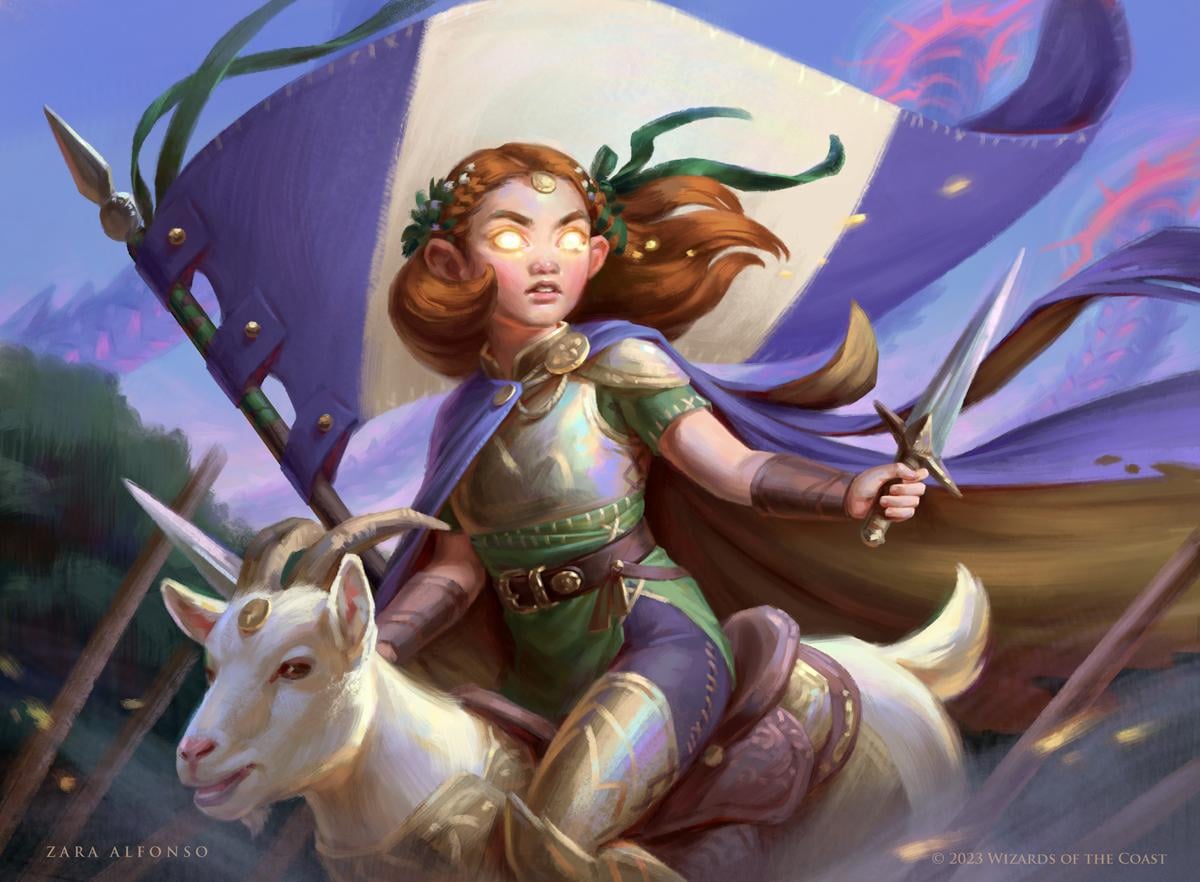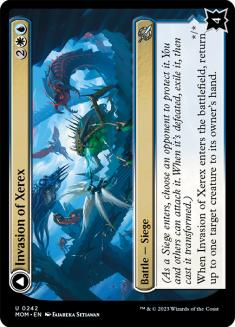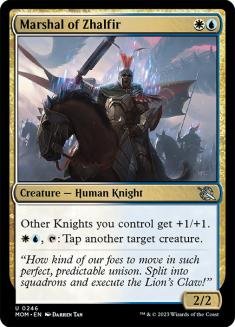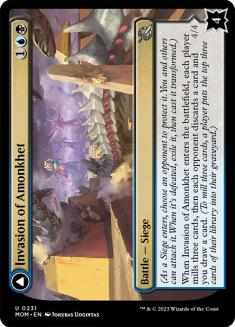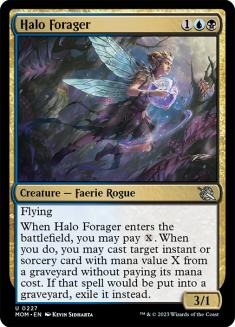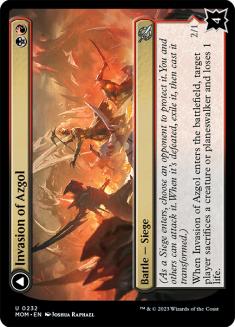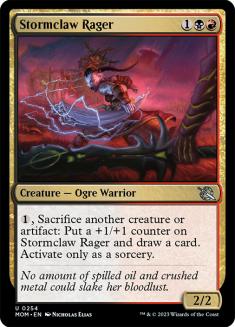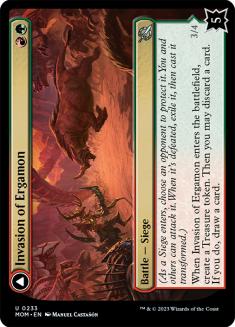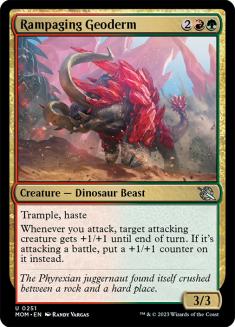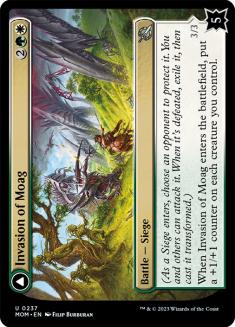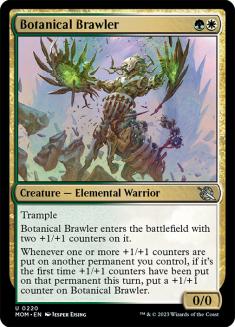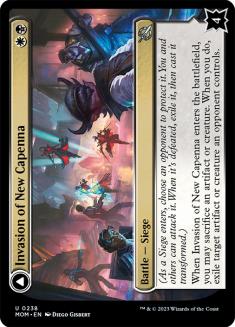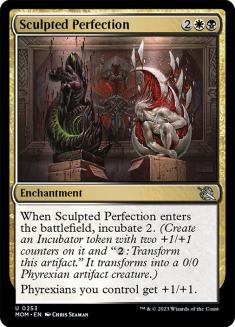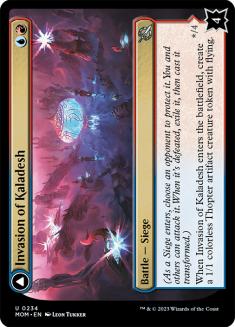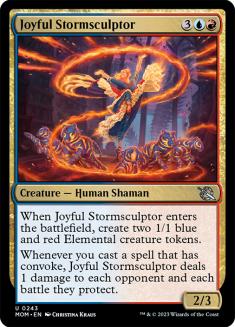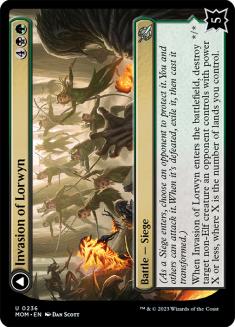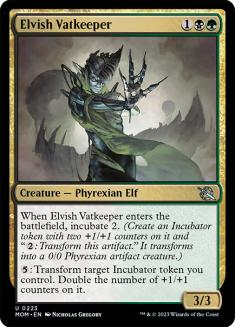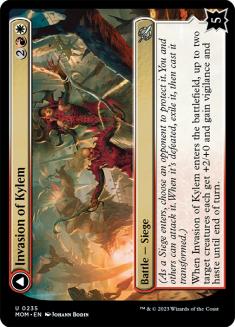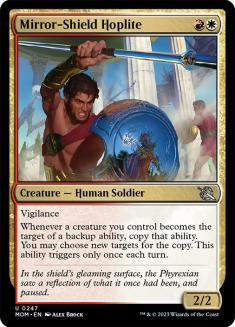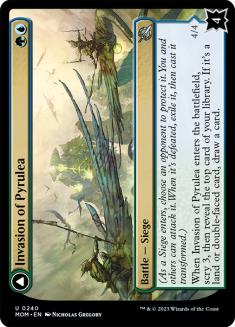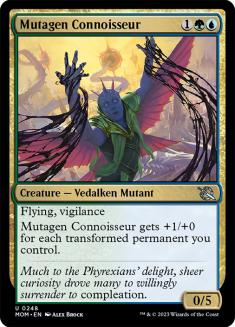This weekend I went outside, and promptly went back indoors to my LGS to get my mitts on some of that sweet new cardboard. I’m really pumped for March of the Machine and with another Pro Tour weeks away, I hope to master it in short order. To get everyone up to speed, I want to provide an overhead view of the Limited archetypes, and what I believe to be the key cards and paths to victory.
Azorius: Knights
Azorius attacks from a different angle from what we’re used to. No longer masters of the sky, Azorius looks to the ground with a creature-based theme of Knights. Though blue and white both provide flyers, most aren’t overly exciting for the deck, aside from Preening Champion, which is always great, regardless of the deck.
The strongest iteration of the deck uses creatures like Swordsworn Cavalier and Protocol Knight to keep opponents on the back foot. Invasion of Belenon and Invasion of Kamigawa fit perfectly into the tempo gameplan of the deck, and it shouldn’t be too difficult to take out some battles.
Swordsworn Cavalier and Zhalfirin Lancer are potent threats, with the latter being able to trigger multiple times off of something like Knight of the New Coalition. Order of the Mirror is another great card for the deck, with the backside being able to attack past most early game creatures. I’m not entirely certain what tricks are best for this deck, but Scrollshift has a lot of potential in Azorius, with the abundance of enters-the-battlefield effects between the two colors. With an ample amount of vigilance creatures in the deck, convoke cards like Aerial Boost can swing a game out of nowhere.
Dimir: Hard Control
Dimir looks to be the most control-oriented deck of the format, aiming to efficiently address threats and gain card advantage along the way. It doesn’t look towards mill as an outright win condition; instead, cards like Expedition Lookout or Tenured Oilcaster care about the size of your opponent’s graveyard, reminiscent of Soaring Thought-Thief and associates from Zendikar Rising. Most of the mill cards will hit both players, and you can gain value through your graveyard with cards like Unseal the Necropolis, Flitting Guerrilla, and Halo Forger.
This is also one of the few decks where Stasis Field looks serviceable. Oracle of Tragedy is amazing in this archetype, allowing you to keep your deck full of threats when they die or get milled, and Furtive Analyst may have a home in this deck as well. Etched Familiar is likely going to be one of the best common creatures for the deck, allowing you to trade off with most creatures and pad your life total at the same time. Invasion of Eldraine seems like a solid battle for the deck, as you should be able to line up getting your opponent’s last two cards in hand; it also feeds into their graveyard count. Running counterspells will be dependent on the rest of the cards in your deck, but this will likely be the best archetype for them.
Rakdos: Sacrifice
Rakdos is up to its normal sacrifice shenanigans we all know and love. It also plays host to the best removal spells, like Collective Nightmare, Deadly Derision, Stoke the Flames, and Volcanic Spite. Red brings the spice with a Threaten effect via Furnace Reins, which is pretty close to a kill spell in this archetype when we take a look at the sacrifice synergies.
The sacrifice payoffs come in the form of Ichor Shade, Corrupted Conviction, and Compleated Huntmaster, among many, many others. In terms of sacrifice fodder, we can find some unwilling volunteers in Ichor Drinker, Nezumi Informant, Ral’s Reinforcements, and my personal favorite, Beamtown Beatstick (you can sacrifice Treasures to most things). With so many removal spells between common and uncommon, it will be important to find a good balance of creatures as well. The deck has a ton going for it, with a deep roster of playables, which puts it in a good spot to come up with some creative builds!
Gruul: Beatdown (Especially of Battles)
While Gruul is still the beatdown deck we have all grown accustomed to, it has a sub-theme of attacking (and defeating) battles. Creatures like War-Trained Slasher, Thrashing Frontliner, and War Historian are eager to jump into any fray on any plane, including the bike racks after school.
While all the battles in Gruul seem like great inclusions, Invasion of Muraganda seems like the premier option for Gruul, and I think I’d be happy to splash some powerful off-color battles if you have the creatures to support it. Portent Tracker seems like a solid inclusion to ramp to bigger creatures and help win or defend battles accordingly. Cosmic Hunger is going to be one of the best removal spells in the deck, which also enables your big creatures to eat an entire battle at instant speed!
Selesnya: +1/+1 Counters
Selesnya is all about +1/+1 counters and not much else. It aims to put out bigger and better creatures, distributing counters where they will be most effective to outsize your opponents. Kami of Whispered Hopes turns into a huge threat, triggering off backup and anything that incubates. It’s also important to keep in mind that you can add +1/+1 counters to Incubator tokens before they hatch!
Both Alabaster Host Sanctifier and Kithkin Billyrider will be potent threats here, warping the game entirely once they get a +1/+1 counter or two. There are further cards that add +1/+1 counters, like Storm the Seedcore, which is a card that looks great on paper but will likely underperform, similarly to Defend the Celestus. On the other hand, Angelic Intervention looks to be a fantastic trick for the deck, protecting your key creatures and adding a counter for your trouble!
Orzhov: Phyrexians
The name of the game creature type in Orzhov is Phyrexian, and don’t forget it. The deck is a midrange deck, using removal to hit key targets while going wide via an abundance of Incubator tokens (Phyrexians when hatched). There’s no shortage of fantastic Phyrexian creatures to enlist, with Norn’s Inquisitor, Attentive Skywarden, Etched Familiar, and Phyrexian Gargantua being some noteworthy options. Phyrexian Censor is at its absolute best in this deck, and can make a huge impact on the game, whether you know it or not.
Phyrexian Awakening is actually one of the incubate enchantments I like by itself, but you have the opportunity to combine it with Gift of Compleation and Sculpted Perfection in this deck, which seems quite strong. Invasion of Belenon is the battle of choice for the deck, further bolstering the Phyrexians upon its inevitable defeat.
Izzet: Spell Aggression
Izzet is the deck I got the most reps in with this weekend, which is pretty typical for me at this point, as it’s often the most fun archetype to both play and figure out early. I had the most success with aggressive builds, highlighted with Khenra Spellspear, a strong contender for the best uncommon in the set. Ral’s Reinforcements is at its absolute best in this deck, increasing in power with each convoke card you fit into the deck, as well as using cards like Mirran Banesplitter or Burning Sun’s Fury to let them trade up with other creatures in the mid-game.
Flywheel Racer actually seemed quite good here, and I could see the same being true for Marauding Dreadship, though I haven’t tried it just yet. This is a great home for Invasion of Mercadia, with the other Invasions all being great in my experience as well. Captive Weird is a lot better than it appears, as it blocks most things in the early-game while providing mana for convoke spells.
Golgari: Incubate Ramp / Go Big
Golgari doesn’t have as much of a supported theme as the other guilds. I’d say it’s more of a ramp / go big deck than the advertised incubate theme. Golgari will likely be one of the best green shells to house splashes. Green offers Blighted Burgeoning, Fertilid’s Favor, and Invasion of Zendikar to ramp and enable splashes, while black can address threats with a loaded arsenal of removal spells. Failed Conversion actually looks like a serviceable removal spell for the deck, keeping your draws relevant for the late-game.
Golgari also has access to the biggest land cyclers, like Gloomfang Mauler, Injector Crocodile, and Timberland Ancient, which will help to make sure you don’t miss any land drops. Incubate is a slow mechanic for the deck, so I would be hesitant to put too many in the deck to avoid being run over. This does look like one of the best decks for Tangled Skyline, which will help avoid losing to evasive creatures once you start laying down big threats.
Boros: Backup and Beatdown
Boros is all about backup and beatdown, a traditional aggro deck that wants to end the game before you run out of gas. You will want to make sure you have plenty of two-drops to apply pressure as early as possible, like Sun-Blessed Guardian, Swordsworn Cavalier, and Ral’s Reinforcements. Invasion of Regatha is great in this deck as well; hitting your opponent for four and picking off an X/1 blocker for three mana is quite the deal.
While removal is nice, combat tricks are extremely potent in this deck and are much easier to acquire during the draft, allowing you to put more priority on potent threats. Aerial Boost and Burning Sun’s Fury are at their best in this deck and enable the big attacks you are looking for. Boros has access to almost the entire armory in March of the Machine, with Kor Halberd, Beamtown Beatstick, Mirran Banesplitter, Kitesail, and Ramosian Greatsword. The deck will be happy with any of them, but likely doesn’t want more than two pieces.
Kithkin Billyrider, Bola Slinger, and Trailblazing Historian are creatures that will really shine in this deck. Karsus Depthguard also has huge potential in this deck, with the caveat that it will require enough backup or Equipment to allow it to attack reliably.
Simic: Transform
The Simic gimmick is transform, which includes Incubator tokens, transform creatures, and battles. The deck is on the slow side, in traditional Simic fashion, but if able to stabilize early, it can run away with the game.
While Overgrown Pest looks good in any deck, Simic will likely provide the most double-faced cards to pick from. The signpost creature, Mutagen Connoisseur, is the saving grace for the deck, and I’m a big believer in the Mutant. A five-toughness vigilance flyer is incredibly difficult to get around, and once this gets a couple of points of power, it starts taking out battles and getting bigger. Corruption of Towashi does say that any transform trigger will draw you a card, which can take over a game by itself.
The main concern for the deck is surviving the early-game, so it’s important to make sure you get two-drops that can trade off, like Iridescent Blademaster, Expedition Lookout, or Wary Thespian, with the intention to use them as early blockers while you set up. This is the deck for Omen Hawker (if there is one), which can help transform creatures more efficiently (including Incubator tokens), as well as pay for cycling costs. Efficient pseudo-removal, like Ephara’s Dispersal, is likely to be one of the best tricks for the deck.
I hope this helps to provide some insight as we all dive into the new set this week!
Lose and Learn, Learn and Win!

